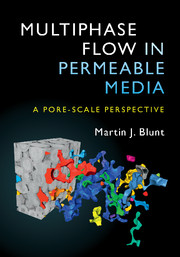Book contents
- Frontmatter
- Dedication
- Contents
- Preface
- Acknowledgements
- List of Symbols
- 1 Interfacial Curvature and Contact Angle
- 2 Porous Media and Fluid Displacement
- 3 Primary Drainage
- 4 Imbibition and Trapping
- 5 Wettability and Displacement Paths
- 6 Navier-Stokes Equations, Darcy's Law and Multiphase Flow
- 7 Relative Permeability
- 8 Three-Phase Flow
- 9 Solutions to Equations for Multiphase Flow
- Appendix Exercises
- References
- Index
- Plate section
5 - Wettability and Displacement Paths
Published online by Cambridge University Press: 15 February 2017
- Frontmatter
- Dedication
- Contents
- Preface
- Acknowledgements
- List of Symbols
- 1 Interfacial Curvature and Contact Angle
- 2 Porous Media and Fluid Displacement
- 3 Primary Drainage
- 4 Imbibition and Trapping
- 5 Wettability and Displacement Paths
- 6 Navier-Stokes Equations, Darcy's Law and Multiphase Flow
- 7 Relative Permeability
- 8 Three-Phase Flow
- 9 Solutions to Equations for Multiphase Flow
- Appendix Exercises
- References
- Index
- Plate section
Summary
Definitions and Capillary Pressure Cycles
We will now consider displacement after primary drainage when the invading phase is no longer, or at least not necessarily, wetting. This is the more likely case in oilfield applications, where, as described in Chapter 2.3.3, most reservoir rocks have a mix of water-wet and oil-wet pores during waterflooding. The distribution of contact angles for different displacement processes is determined by the mineralogy and roughness of the rock surface, the oil and brine compositions, as well as the capillary pressure and water saturation at the end of primary drainage; it will vary on a pore-by-pore basis.
Hitherto, we have defined imbibition to refer to a displacement where the advancing phase has a contact angle of less than 90°. While this is a convenient definition for simple cases, it is neither precise nor practical for displacement in porous media for two reasons. Firstly, the contact angle is not constant; many rocks have contact angles both less than and greater than 90°. Secondly, as seen in Chapter 4.2.2 for cooperative pore filling processes, even if the contact angle is less than 90°, the threshold capillary pressure for displacement may be negative, implying that the apparently wetting phase needs a higher pressure than the non-wetting phase to advance. In macroscopic experiments the externally imposed capillary pressure is measured: this cannot distinguish between a negative capillary pressure for an event with a contact angle less than 90° from one where the advancing phase is non-wetting with a contact angle greater than 90°.
From now on, a more pragmatic definition of imbibition and drainage will be employed, appropriate to describe macroscopic displacement processes in porous media, based on the sign and direction of change of the capillary pressure. The oil/water capillary pressure is defined as the externally imposed pressure difference between oil and water in a displacement at a very slow flow rate. Pcm = Pl - Pd , where d refers to the denser phase and l to the less dense phase, following the same convention used to define contact angle in Chapter 1.
Information
- Type
- Chapter
- Information
- Multiphase Flow in Permeable MediaA Pore-Scale Perspective, pp. 188 - 218Publisher: Cambridge University PressPrint publication year: 2017
